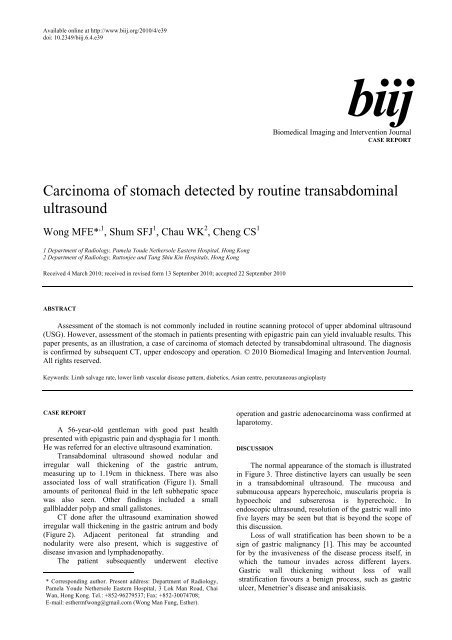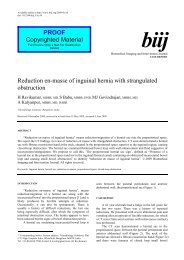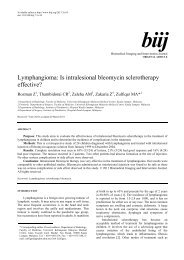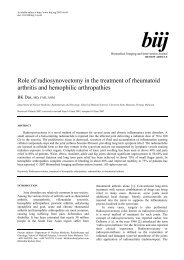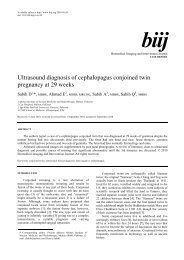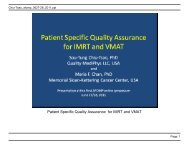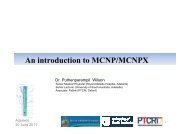Carcinoma of stomach detected by routine transabdominal ultrasound
Carcinoma of stomach detected by routine transabdominal ultrasound
Carcinoma of stomach detected by routine transabdominal ultrasound
You also want an ePaper? Increase the reach of your titles
YUMPU automatically turns print PDFs into web optimized ePapers that Google loves.
Available online at http://www.biij.org/2010/4/e39<br />
doi: 10.2349/biij.6.4.e39<br />
biij<br />
Biomedical Imaging and Intervention Journal<br />
CASE REPORT<br />
<strong>Carcinoma</strong> <strong>of</strong> <strong>stomach</strong> <strong>detected</strong> <strong>by</strong> <strong>routine</strong> <strong>transabdominal</strong><br />
<strong>ultrasound</strong><br />
Wong MFE* ,1 , Shum SFJ 1 , Chau WK 2 , Cheng CS 1<br />
1 Department <strong>of</strong> Radiology, Pamela Youde Nethersole Eastern Hospital, Hong Kong<br />
2 Department <strong>of</strong> Radiology, Ruttonjee and Tang Shiu Kin Hospitals, Hong Kong<br />
Received 4 March 2010; received in revised form 13 September 2010; accepted 22 September 2010<br />
ABSTRACT<br />
Assessment <strong>of</strong> the <strong>stomach</strong> is not commonly included in <strong>routine</strong> scanning protocol <strong>of</strong> upper abdominal <strong>ultrasound</strong><br />
(USG). However, assessment <strong>of</strong> the <strong>stomach</strong> in patients presenting with epigastric pain can yield invaluable results. This<br />
paper presents, as an illustration, a case <strong>of</strong> carcinoma <strong>of</strong> <strong>stomach</strong> <strong>detected</strong> <strong>by</strong> <strong>transabdominal</strong> <strong>ultrasound</strong>. The diagnosis<br />
is confirmed <strong>by</strong> subsequent CT, upper endoscopy and operation. © 2010 Biomedical Imaging and Intervention Journal.<br />
All rights reserved.<br />
Keywords: Limb salvage rate, lower limb vascular disease pattern, diabetics, Asian centre, percutaneous angioplasty<br />
CASE REPORT<br />
A 56-year-old gentleman with good past health<br />
presented with epigastric pain and dysphagia for 1 month.<br />
He was referred for an elective <strong>ultrasound</strong> examination.<br />
Transabdominal <strong>ultrasound</strong> showed nodular and<br />
irregular wall thickening <strong>of</strong> the gastric antrum,<br />
measuring up to 1.19cm in thickness. There was also<br />
associated loss <strong>of</strong> wall stratification (Figure 1). Small<br />
amounts <strong>of</strong> peritoneal fluid in the left subhepatic space<br />
was also seen. Other findings included a small<br />
gallbladder polyp and small gallstones.<br />
CT done after the <strong>ultrasound</strong> examination showed<br />
irregular wall thickening in the gastric antrum and body<br />
(Figure 2). Adjacent peritoneal fat stranding and<br />
nodularity were also present, which is suggestive <strong>of</strong><br />
disease invasion and lymphadenopathy.<br />
The patient subsequently underwent elective<br />
* Corresponding author. Present address: Department <strong>of</strong> Radiology,<br />
Pamela Youde Nethersole Eastern Hospital, 3 Lok Man Road, Chai<br />
Wan, Hong Kong. Tel.: +852-96279537; Fax: +852-30074708;<br />
E-mail: esthermfwong@gmail.com (Wong Man Fung, Esther).<br />
operation and gastric adenocarcinoma wass confirmed at<br />
laparotomy.<br />
DISCUSSION<br />
The normal appearance <strong>of</strong> the <strong>stomach</strong> is illustrated<br />
in Figure 3. Three distinctive layers can usually be seen<br />
in a <strong>transabdominal</strong> <strong>ultrasound</strong>. The mucousa and<br />
submucousa appears hyperechoic, muscularis propria is<br />
hypoechoic and subsererosa is hyperechoic. In<br />
endoscopic <strong>ultrasound</strong>, resolution <strong>of</strong> the gastric wall into<br />
five layers may be seen but that is beyond the scope <strong>of</strong><br />
this discussion.<br />
Loss <strong>of</strong> wall stratification has been shown to be a<br />
sign <strong>of</strong> gastric malignancy [1]. This may be accounted<br />
for <strong>by</strong> the invasiveness <strong>of</strong> the disease process itself, in<br />
which the tumour invades across different layers.<br />
Gastric wall thickening without loss <strong>of</strong> wall<br />
stratification favours a benign process, such as gastric<br />
ulcer, Menetrier’s disease and anisakiasis.
Wong et al. Biomed Imaging Interv J 2010; 6(4):e39 2<br />
This page number is not<br />
for citation purposes<br />
Figure 3 Transverse scan <strong>of</strong> the upper abdomen <strong>of</strong> a normal<br />
patient. Ring down artifacts (arrows) are suggestive <strong>of</strong><br />
intraluminal gas in the <strong>stomach</strong>. Different layers <strong>of</strong><br />
<strong>stomach</strong>: 1. echogenic mucousa and submucousa; 2.<br />
hypoechoic muscularis propria; and 3. echogenic<br />
subserosa.<br />
Figure 1 a) Transverse scanning <strong>of</strong> the upper abdomen <strong>of</strong> the<br />
patient. Nodular and irregular thickening <strong>of</strong> the gastric<br />
antrum with loss <strong>of</strong> wall stratification (arrows); b)<br />
Transverse scan <strong>of</strong> the upper abdomen after patient<br />
takes in water. Wall thickening up to 1.19 cm.<br />
Figure 2 Complementary plain CT <strong>of</strong> the patient confirms<br />
thickening <strong>of</strong> the <strong>stomach</strong> wall. Adjacent peritoneal<br />
stranding and nodularity (arrows) is seen, which is<br />
suggestive <strong>of</strong> disease invasion.<br />
Apart from loss <strong>of</strong> wall stratification, the degree <strong>of</strong><br />
gastric wall thickening also gives a clue to the nature <strong>of</strong><br />
underlying disorder. The sonographic thickness <strong>of</strong><br />
normal gastric body and antral wall measures up to 5mm<br />
in a non-distended state [2]. Wall thickening <strong>of</strong> a lesser<br />
extent (5-8mm) favours benign causes, such as chronic<br />
gastritis and gastric ulcer.[3]. In malignant causes, the<br />
degree <strong>of</strong> thickening is greater, with average thickness<br />
reported to be 15.9 mm in a study [4].<br />
In a healthy population, visualisation <strong>of</strong> the gastric<br />
antrum has been reported to be up to 100%, while the<br />
body and fundus is less consistently seen [5].<br />
Transabdominal <strong>ultrasound</strong> examination has also been<br />
shown to have high efficacy in visualising gastric<br />
carcinoma [6]. Despite these promising results, however,<br />
the detection <strong>of</strong> gastric tumours in real life practice<br />
depends on patient habitus, location and staging <strong>of</strong> the<br />
gastric tumour.<br />
In most centres, <strong>routine</strong> scanning protocol <strong>of</strong> the<br />
upper abdomen includes the liver, gallbladder, pancreas,<br />
kidneys and spleen. Little attention has been paid to the<br />
<strong>stomach</strong>. It is a common belief among sonographers and<br />
radiologists that gastric pathology cannot be picked up<br />
<strong>by</strong> <strong>ultrasound</strong>. Indeed, some part <strong>of</strong> the gastric wall may<br />
be obscured <strong>by</strong> intraluminal gas. However, ingestion <strong>of</strong><br />
water just before the examination will help to displace<br />
intraluminal gas and provide an acoustic window for<br />
visualisation <strong>of</strong> the posterior wall.<br />
Another limitation in <strong>transabdominal</strong> <strong>ultrasound</strong> is<br />
in the detection <strong>of</strong> early mucousal lesions. Early tumours<br />
that have not yet reached the stage <strong>of</strong> frank submucousal<br />
invasion and formed a reasonable tumour bulk may not<br />
be readily picked up <strong>by</strong> <strong>transabdominal</strong> <strong>ultrasound</strong>. In<br />
such cases, patients with a negative <strong>ultrasound</strong> finding<br />
but with relevant symptoms should not be deferred for<br />
endoscopy. However, frank gastric pathology such as the<br />
one illustrated in this case study should be picked up<br />
during <strong>routine</strong> <strong>ultrasound</strong>, which will guide further<br />
patient management.<br />
In summary, the authors recommend that attention<br />
be paid to gastric wall pathology during <strong>routine</strong> scanning<br />
for patients with relevant symptoms.
Wong et al. Biomed Imaging Interv J 2010; 6(4):e39 3<br />
This page number is not<br />
for citation purposes<br />
REFERENCES<br />
1. Okanobu H, Hata J, Haruma K, Hara M, Nakamura K, Tanaka S<br />
and Chayama K. Giant Gastric Folds: Differential Diagnosis at<br />
US1. Radiology 2003; 226(3):686–690.<br />
2. Fleischer AC, Muhletaler CA and James AE Jr. Sonographic<br />
assessment <strong>of</strong> the bowel wall. Am J Roentgenol 1981; 136(5):887–<br />
891.<br />
3. Fujishima H, Misawa T, Chijiwa Y, Maruoka A, Akahoshi K and<br />
Nawata H. Scirrhous carcinoma <strong>of</strong> the <strong>stomach</strong> versus<br />
hypertrophic gastritis: findings at endoscopic US. Radiology.1991;<br />
181(1):197–200.<br />
4. Rapaccini GL, Aliotta A, Pompili M, Grattagliano A, Anti M,<br />
Merlino B and Gambassi G. Gastric wall thickness in normal and<br />
neoplastic subjects: A prospective study performed <strong>by</strong> abdominal<br />
<strong>ultrasound</strong>. Abdominal Imaging 1988; 13(1):197–199.<br />
5. Perlas A, Chan VWS, Lupu CM, Mitsakakis N and Hanbidge A.<br />
Ultrasound Assessment <strong>of</strong> Gastric Content and Volume.<br />
Anesthesiology 2009; 111(1): 82–89.<br />
6. Singh S and Chowdhury V. Efficacy <strong>of</strong> high resolution<br />
transabadominal sonography <strong>of</strong> the fluid filled <strong>stomach</strong> in the<br />
evaluation <strong>of</strong> gastric carcinomas. Indian Journal <strong>of</strong> Radiological<br />
Imaging 2005; 15(4):421–426.


